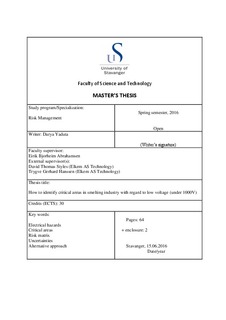| dc.description.abstract | Elkem has got smelting plants worldwide. Five of them are located in Norway. Smelting of metal takes place in electrical arc furnaces, for example, in Elkem Thamshavn. The electrical arc occurs between furnace electrodes and furnace charge. Thereby it causes a melting (Schei, Tuset, & Tveit, 1998), (Elkem AS, 2016a).
Elkem smelting plants have many working areas with potential hazards related to the personnel which refer to current, high temperatures, amount of energy concentrations etc. Due to its industry specialty, smelting industry needs tailored standards. Therefore, a need for the implementation of the methodology appeared. It should identify critical areas that could be a starting point in the development of a standard. The assessment of working areas’ criticality regarding to low voltage will be in focus in this thesis. Identification of such critical areas is an important task, since management can prioritize the areas that have been identified (Aven, 2009).
A common definition of criticality is following (Aven, 2009, p. 404):
“A system is considered critical if its failure or malfunctions may results in severe consequences”. The consequences can involve environmental damage, loss of lives, etc.
By identification of critical areas it can be identified how one can distribute resources and activities concerning investments in safety and risk reducing measures (Aven, 2009).
What kind of tool will be the best to use in this case? Is it the best to use methods that are well established as, for example, risk matrix or is it more useful to introduce other tools?
The selection of methods in many cases depends on the available historical data. By using the available data, the following sources were found:
- Information from external sources, for instance, Accident statistic from Norwegian Directorate for Civil Protection [DSB] did not contain required information.
- Data from internal sources, as Synergi Life database, were limited.
Risk matrix is a widespread tool in many companies and it is used for qualitative risk assessment. However, it is a tool with limitations (Flage & Røed, 2012). Issues related to the risk matrix, among other things are the subjective classification of the probability and consequence, the consistency between quantitative measures and risk matrix, etc. Thus, risk matrix is used to performing a crude risk analysis and cannot be used alone for decision-making.
It is questionable whether this method will be the best option for smelting industry. Thus, an alternative approach may be suggested. It is related to expected values and uncertainties in underlying phenomena and processes (Aven, 2009).
This alternative approach does not need a large amount of data and can be applied for ranking a few areas. For instance, it could be used to identify top five most critical working areas. Using of this ranking tool requires high knowledge related to smelting plants and the actual process. It is clear, that by including the uncertainty in the assessment of criticality the accuracy of the results will be higher. Nevertheless, the approach suggested by Aven (2009) needs some adjustments before it can be used in practice. For instance, when different areas have the same type of consequences but probabilities P (A) is different or when some areas have the same type of uncertainties but different probabilities. In such cases, there is not a straight way forward how to rank the actual areas.
In addition, the alternative method for identification of critical areas was introduced in 2009. Since then there have been new studies related to this approach. Goerlandt and Reniers (2015) introduce how the assessment of uncertainties can be improved. Moreover, Aven (2013) showed the different new risk perspectives, inter alia, uncertainties based risk definitions in real-life situations. The risk description done in this way has a great impact on risk management and decision-making (Aven, 2009).
In light of new research the alternative approach could be modified. The suggested improvement are as following:
- Insert the colors for assessment of risk indices expressing the expected consequences.
- Use the improved classification scheme for uncertainties.
- Include the assessment of knowledge in risk assessment.
Since the focus was to develop a method for identifying the critical areas for own workers and contractors, the results will be hypothetical. | nb_NO |

